In case you haven't heard, COVID-19’s public health emergency (PHE) and national emergency (NE) are coming to a close. The Biden administration announced that both emergencies will terminate on May 11, 2023. In addition to the cessation of various group health plan obligations to provide certain COVID-19-related items/services without cost-sharing under the PHE and the end to the extended deadlines under the NE’s “outbreak period,” the PHE’s expiration will also lead to the unwinding of Medicaid continuous coverage protection.
Starting as early as February 2023, state agencies in charge of Medicaid may begin the process of redetermining which Medicaid participants may no longer be eligible and, consequently, dropped from Medicaid starting April 1, 2023. The exact timing will vary by state. More information regarding when a particular state will begin this re-evaluation process may be found here (opens a new window).
Key Takeaways
The Medicaid redetermination process will result in numerous individuals losing their current Medicaid coverage.
Loss of Medicaid coverage is a HIPAA special enrollment right, allowing individuals to return to employer-sponsored coverage mid-year if they provide notice within 60 days.
Bottom line: Employers may see a significant uptick in covered employees and family members in the coming months.
Background
The Families First Coronavirus Response Act, passed in early 2020, increased federal Medicaid funding for states that agreed to allow anyone already enrolled or who became enrolled in Medicaid during the PHE to remain enrolled throughout the PHE, even if their eligibility status changed. This continuous coverage rule increased Medicaid enrollment by roughly 30% to approximately an additional 18 million participants. Legislation passed late last year allows states to redetermine eligibility and begin involuntary terminations. It is estimated that roughly 6 million individuals who lose Medicaid coverage will be eligible for coverage under an employer-sponsored health plan.
Effect on Employer-Sponsored Medical Plans
Losing Medicaid triggers a HIPAA special enrollment right in employer-sponsored medical plans. And, for many employers who allow employees to pay medical premiums on a pre-tax basis through a cafeteria plan, it is also a qualifying election change event. Generally, the window for notifying the plan of losing Medicaid eligibility is 60 days. However, keep in mind that we are still in the Outbreak Period (think NE) through July 10, 2023, so the 60-day window is temporarily extended for anyone losing Medicaid before that date.
Lockton Comment: For example, if an employee were to lose Medicaid eligibility effective April 1, they would (under pre-covid rules) have until May 30th to enroll in their employer-provided medical plan, assuming they are otherwise eligible. This year, however, with the extra padding of time under the NE, their 60-day clock to exercise the HIPAA special enrollment right will not start ticking until the end of the Outbreak Period on July 10, 2023, bringing their deadline to Sept. 8, 2023 (July 10 plus 60 days).
Bring In the Actuaries
From an actuarial perspective, Lockton’s Actuarial Practice anticipates the impact will likely vary greatly from employer to employer, depending on the employer’s situation. The Medicaid redetermination process would be a non-event for some employers, while others could see a significant impact. Here are points that Lockton’s actuaries recommend employers consider:
New members joining a plan due to no longer being eligible for Medicaid could be spread over the next 12 to 18 months.
Federal regulators estimate that 5-6 million people who lose Medicaid coverage will seek enrollment in employer-sponsored health plans. This concurs with other CMS data stating that 15-18 million will lose coverage, and 30-40% will seek coverage through employer-sponsored plans. This represents a potential increase of approximately 3% to the total amount of people currently participating in private insurance (~160M).
Using this as a starting point, we could expect nationwide employer-sponsored plan membership to increase by 3%.
The members coming on to the plan would be expected to have similar costs as those currently on the plan unless other information is available from the client about these members. Thus, the additional members would be expected to result in an increase of 3% cost for employer-sponsored plans.
Based on an employer’s specific situation, the impact could be very close to zero (not noticeable among other changes in membership throughout the year); the impact could also be much higher than 3% for employers that were more affected by the pandemic.
It is believed that those people impacted by the end of the PHE and NE are more likely those whose employment was also impacted during the pandemic (food service, hospitality, service industries).
Employers that were able to move employees to remote working situations during the pandemic and/or didn’t experience a significant loss of workers are not likely to be impacted by this redetermination. These will typically be white-collar industries and those with higher compensated employees.
Lockton Comment: We recommend that employers review historical waiver percentages pre-pandemic and currently. If the percentage of employees that waived coverage pre- to post-pandemic increased, it is an indicator that an influx of new enrollees could impact the plan. Consideration should also be given to additional dependents being added to the plan for employees currently enrolled.
There is no information available to help determine how many of an employer’s employees are currently on Medicaid. If somehow an employer had that information, it is expected that about 13% of Medicaid enrollees will be disenrolled, and only about 26% of those will enroll in private insurance (with the rest either re-enrolling in Medicaid based on qualifications or going uninsured).
Again, for most employers, we do not expect this to be an event to cause any noticeable increase in cost or enrollment; however, for specific employers in certain industries, there could be a cost increase due to the number of new enrollees that should be considered in financials on top of the standard trend.  Download article (opens a new window)
Download article (opens a new window)

